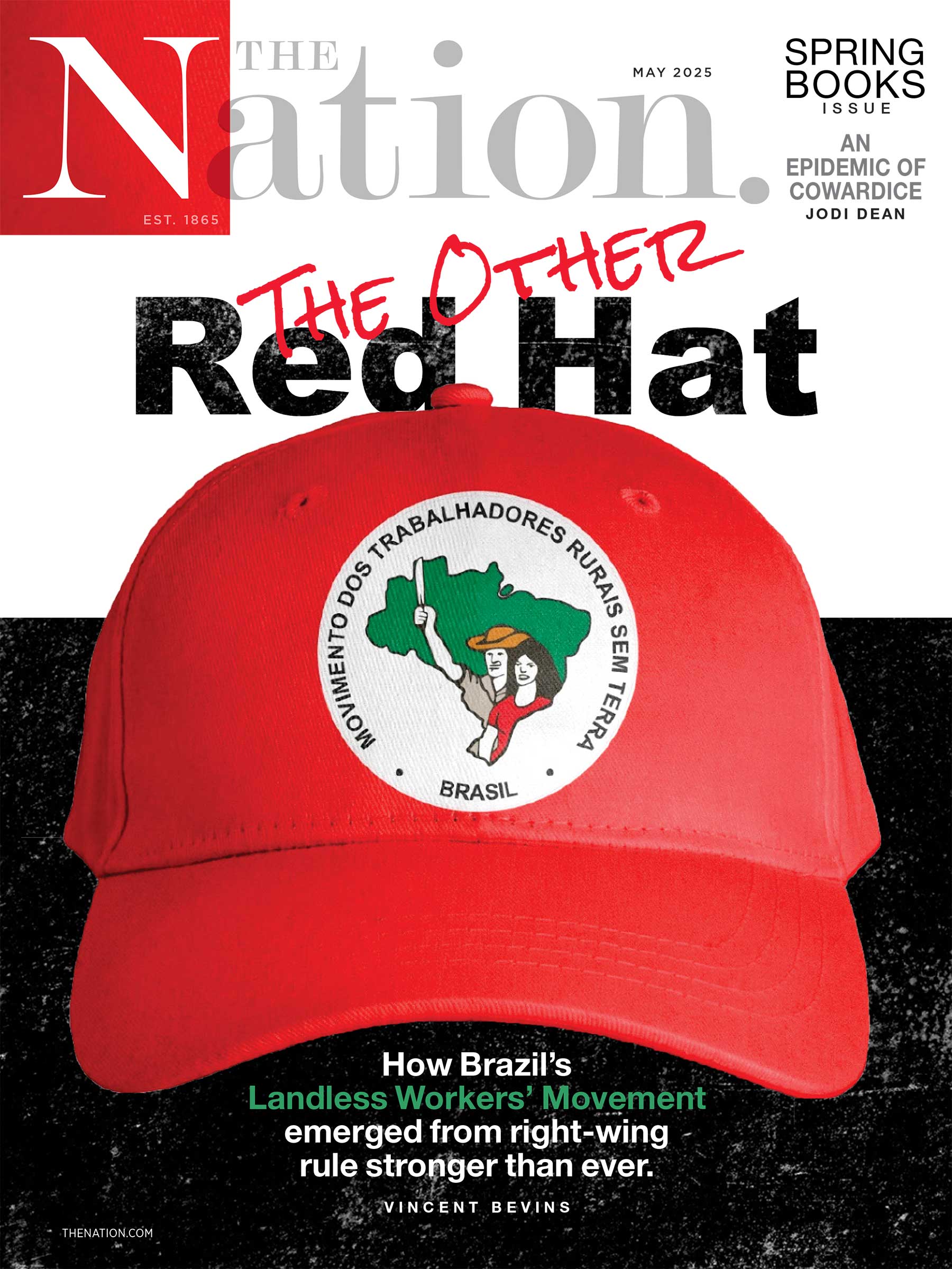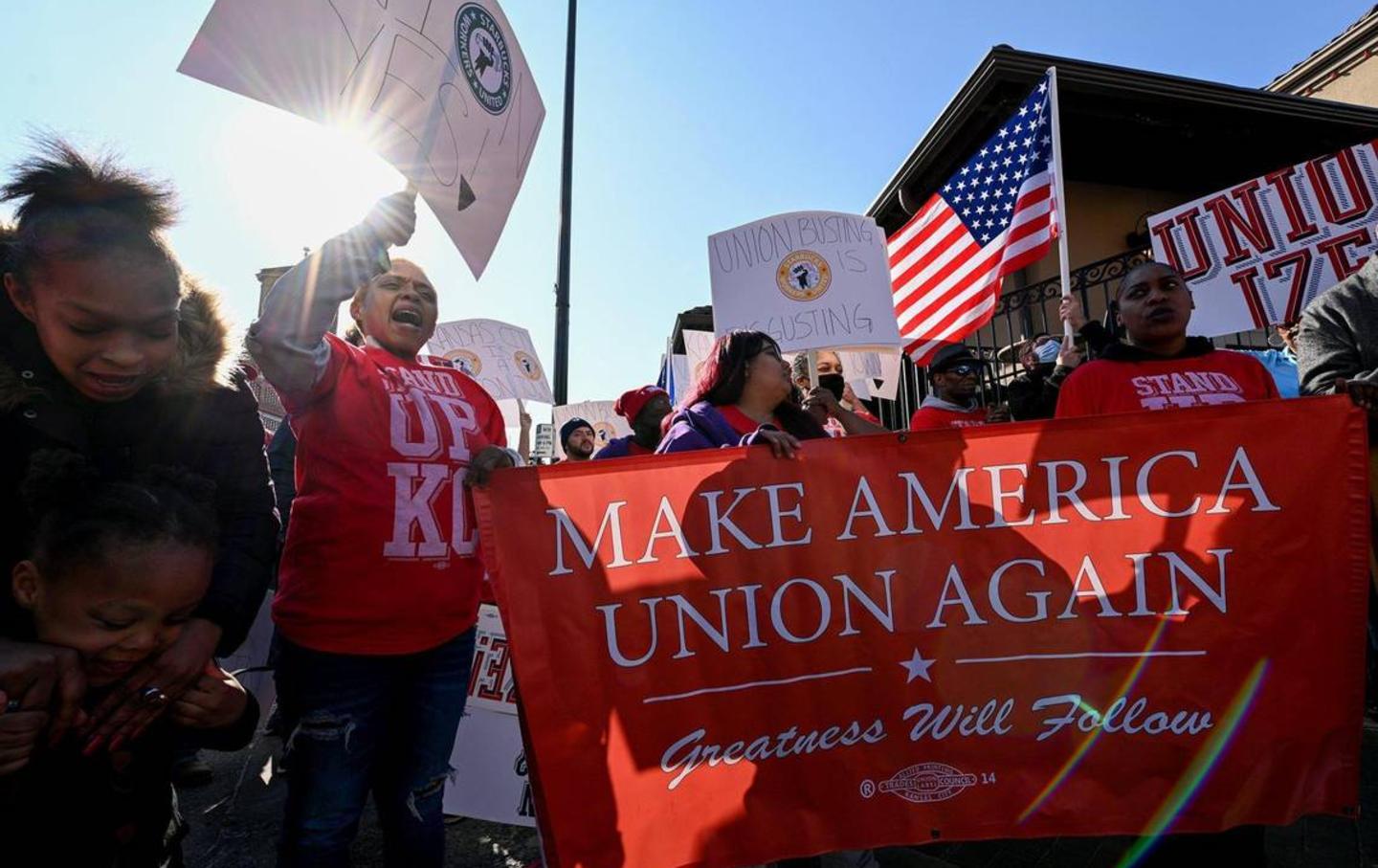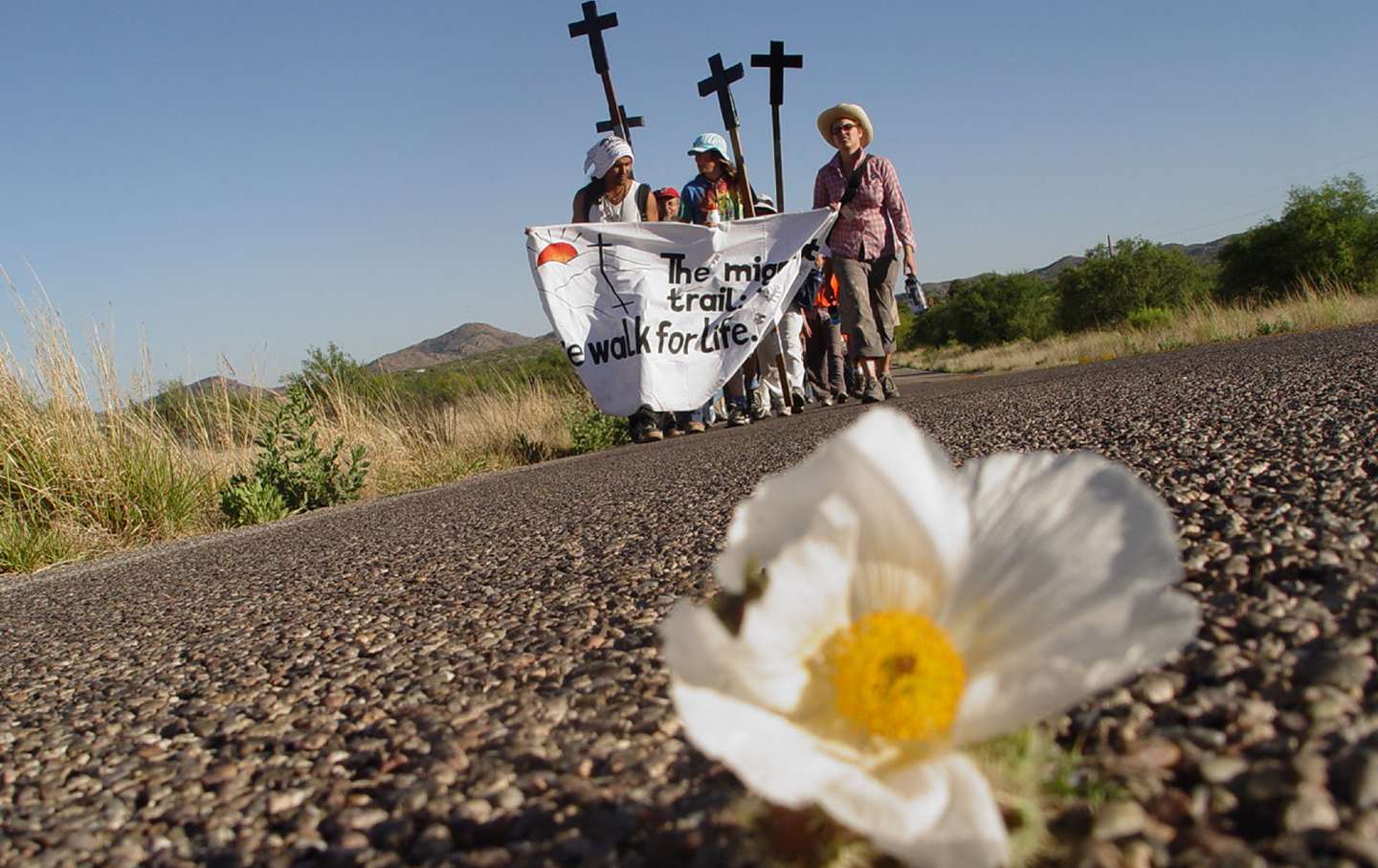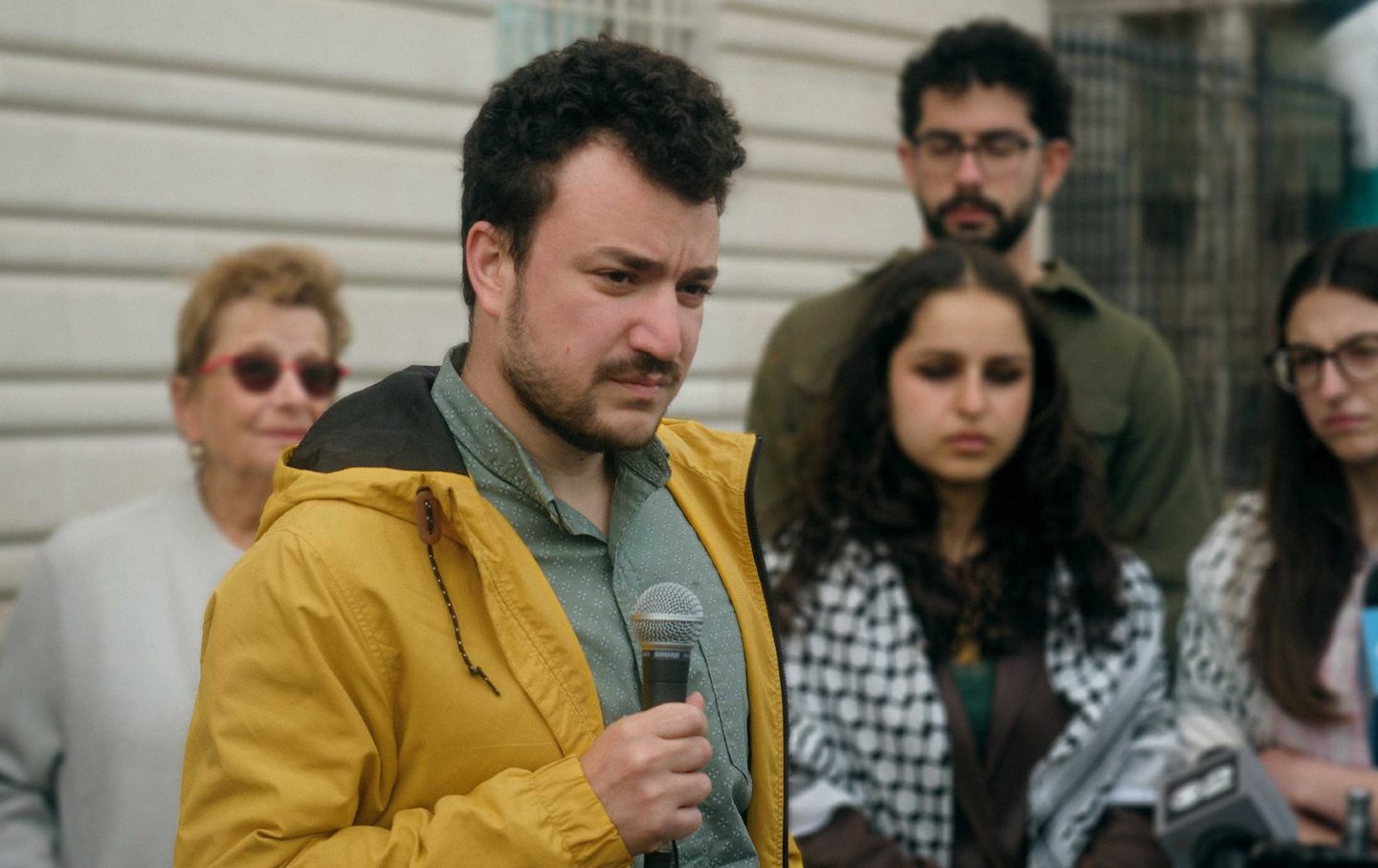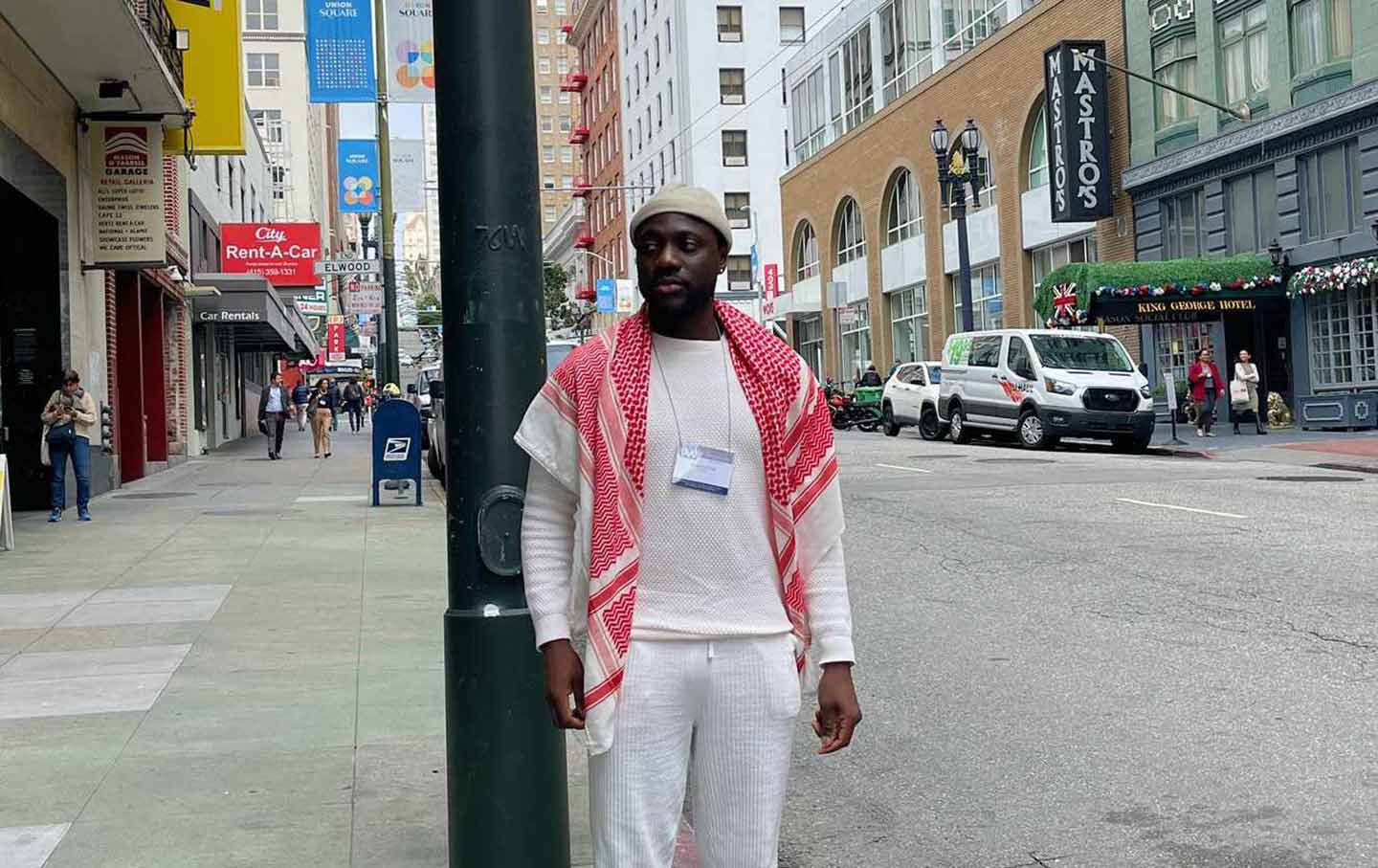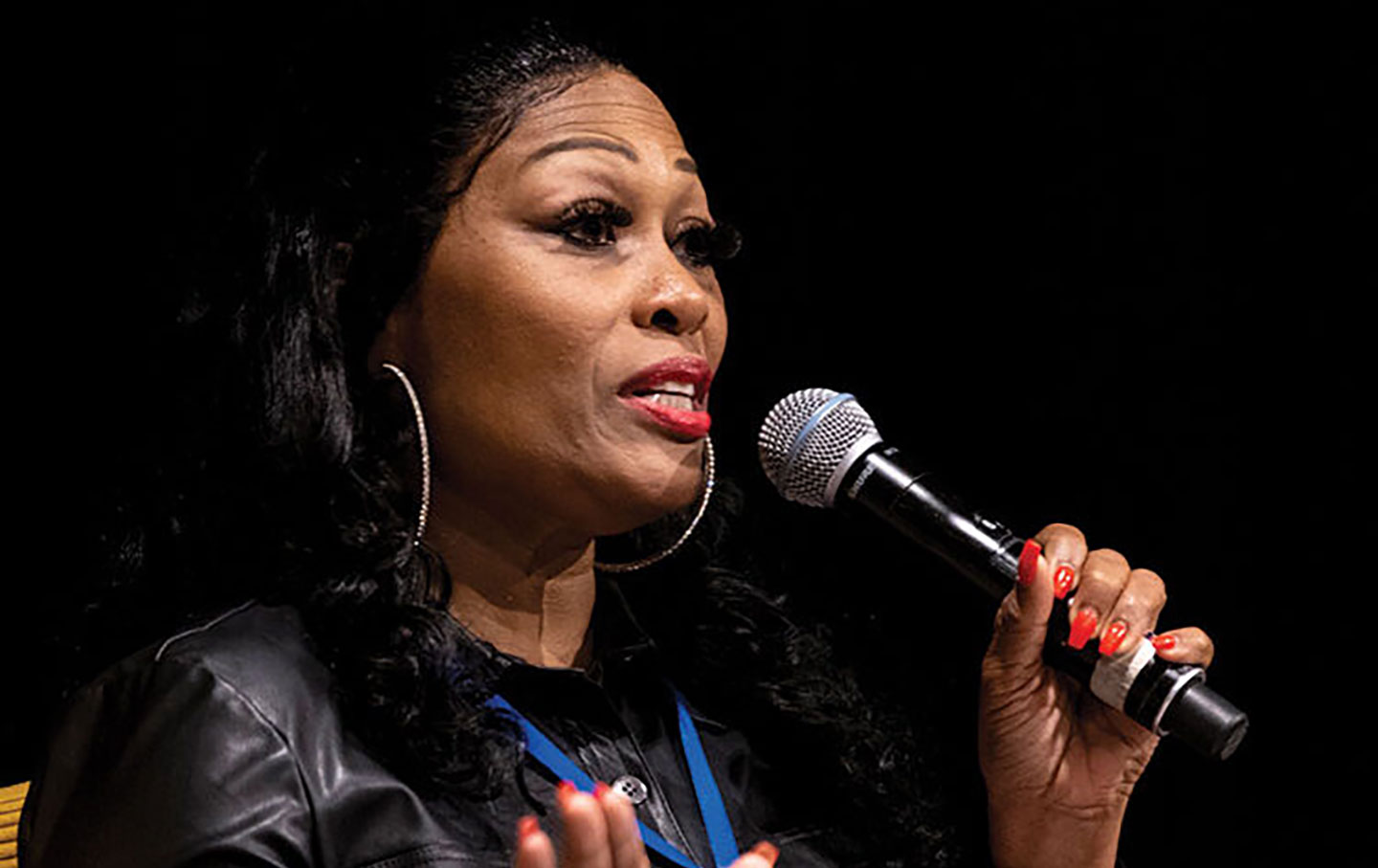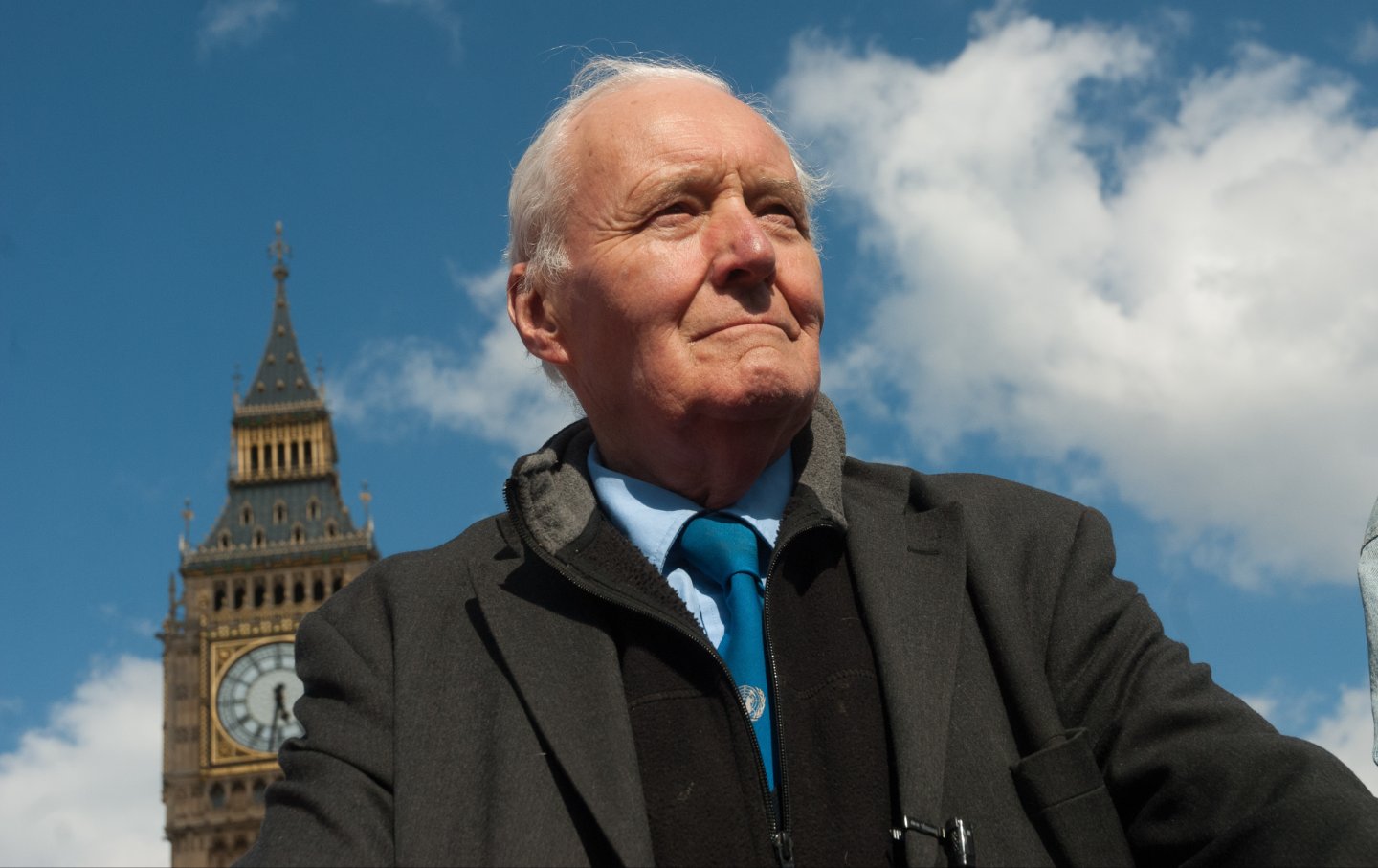There’s Another St. Patrick’s Day Parade in New York—and This One Stands Up to Trump
The St. Pat’s for All parade started when the more famous Fifth Avenue parade barred queer groups. Twenty-six years later, it welcomes Palestinian solidarity organizations.
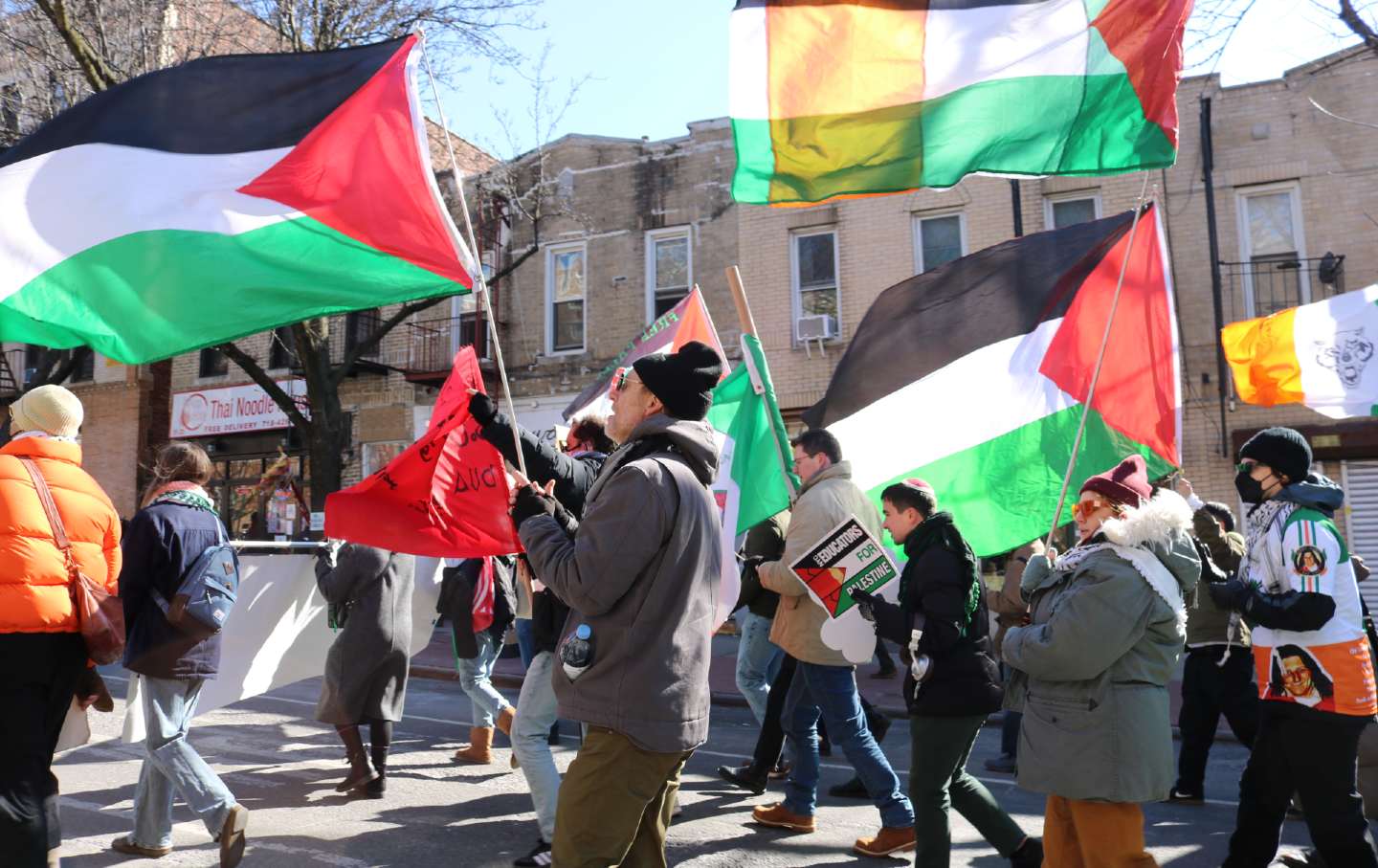
Twenty-six years ago, the St. Pat’s for All parade in Queens, New York, began as a response to the exclusion of Irish LGBTQ communities from the Fifth Avenue parade. Now it welcomes Irish and Irish American solidarity with Palestinians.
(Phoebe Grandi)
Sunnyside and Woodside, Queens, New York City—“We’ve had snow, we’ve had rain, but this is the coldest St. Pat’s parade in our history,” Daniel Dromm, a former New York City councilor, yelled out over the crowd on March 2. Most of the St. Pat’s for All (SPFA) parade goers presumably wore green or rainbow attire under their winter coats, but this Sunday was more about parkas than top-to-bottom Kelly green outfits. Dromm, who’s also a parade organizer, continued, “But we’re surrounded by warmhearted, progressive people who are pro-immigrant.” As he said this, a woman in a green top hat distributed hand warmers to protect fellow parade-goer’s fingers from the sub-freezing temperatures.
Celebrating its 26th anniversary, the inclusive Saint Patrick’s Day parade happens every year in the Queens neighborhoods of Sunnyside and Woodside on the first Sunday of March. Around 100 organizations, bands, and dance groups march down Skillman Avenue cheered on by locals lining the street. This year’s grand marshals were the lord mayor of Belfast, Micky Murray, and the Irish American singer Judy Collins, who was ill and couldn’t attend.
As the opening remarks took place, the parade’s participants situated themselves up 43rd Street. Nestled in a patch of sun, the members of New York Irish for Palestine (NYI4P) were readying themselves to march in SPFA for the first time as an organization. The group had formed exactly a year prior, at the St. Pats for All parade in 2024. “Another group had organized an Irish-Palestine solidarity contingent in the parade,” NYI4P cofounder Sean Liam recalled. “Three of us marched with them, met after, and decided to start a group dedicated to both solidarity with Palestinians and celebrating the Ireland-Palestine connection.”
Since then, the group has gained substantial support from the progressive Irish and Irish American community in New York City. The organization hosts mutual aid fundraisers and “brigils”—vigils on a bridge—on an overpass in Astoria. Their Irish flags decorated with keffiyeh patterns and calls for Palestinian liberation can be found at most pro-Palestine protests and rallies held in the city.
As they waited for the parade to commence, members of the NYI4P handed out their flags and banners. With at least 30 marchers standing behind the large banner that would lead them down Skillman Ave, NYI4P was one of the largest non-performance groups in the parade. With all of their flags and banners, the group was a blur of red, black, white, green, and orange.
The SPFA parade’s commitment to inclusion is a rejection of the historical exclusion of the New York City St. Patrick’s Day Parade that goes along Fifth Avenue to drunken cheers every March 17.
In 1991, the Irish Lesbian and Gay Organization (ILGO) wanted to march in the NYC St. Patrick’s Day Parade; its members, who were tired of feeling forced to choose between the queer community or the Irish community, wanted to show that it was possible to be both publicly queer and Irish.
The Ancient Order of Hibernians (AOH), a male-only Irish Catholic organization that had sponsored the NYC St. Patrick’s Day Parade since the mid-1800s, denied the request. However, District 7 of the AOH went against the wishes of the New York AOH Board and invited ILGO to march with them under the requirement that they didn’t carry any banners or other decorative items. The group accepted the invitation and marched alongside New York Mayor David Dinkins. But ahead of the 1992 parade, the AOH banned ILGO from participating in the parade under any circumstance. In 1992, LGBTQ+ groups sued, lawsuits the NYC St. Patrick’s Day Parade website still refers to as attacks on its “traditional values,” and the AOH officially stopped organizing the parade, the responsibilities for which were assumed by the St. Patrick’s Day Parade, Inc., which upheld the ban on ILGO.
In 1993, following protests of the parade by ILGO and other LGBTQ+ rights organizations,New York City filed an injunction against ILGO, preventing it from marching in the parade or even counterprotesting without risking arrest.
It was not until the fall of 2014 that the parade organizers lifted the ban on openly LGBTQ+ organizations, after significant corporate and political pressure. In 2015, an NBCUniversal LGBTQ+ group became the first openly queer group to march in the parade. The Lavender and Green Alliance, founded in 1994 by former ILGO member Brendan Fay, became the second openly gay organization to march down Fifth Avenue in 2016.
But before that, Fay didn’t want to wait for permission to celebrate New York’s queer Irish community. In 2000, he, alongside Dromm, founded the St Pat’s for All parade. Kathleen Walsh D’Arcy, a current cochair of the parade, explained that Fay “decided that he wanted to do something fun and educational and not get arrested every year. So [in 1994], he started the Lavender and Green Alliance. In the beginning, they had history classes, parties, dinner dances, and all that, but then he decided, ‘Let’s have a parade.’”
Thus, the parade landed in the historically Irish neighborhood of Woodside, which was chosen because of its immigrant population. Woodside remains a magnet for Irish immigrants, but it has large Asian and Latino communities too.
As Dromm remarked to the shivering parade-goers, the St Pat’s for All parade is rooted in resistance, but it’s above all about the joy that can be found in inclusive spaces. “A lot of reporters want to talk about that Fifth Avenue parade exclusion. Twenty-six years later, that is not the story anymore,” D’Arcy said. “I like to accentuate the positive about this parade and talk about how exciting it is, how welcome we are.” With more than 20 blocks lined with people cheering each organization, there is no question that the parade has become a vital part of the Queens community.
Popular
“swipe left below to view more authors”Swipe →Before the start of the parade, most of the speakers talked about resisting the Trump administration. This parade, they said, represented the antithesis of everything that Trump stands for. Most of the speakers, many of whom were local politicians, spoke about the importance of celebrating and protecting trans and immigrant communities. “We know that Woodside is for all,” the frequent SPFA attendee Representative Alexandria Ocasio-Cortez told the growing crowd. “Queens is for all, and New York City is for everybody.”
A few speakers praised the fact that one organization wasn’t there: The Pride Center of Staten Island, which had previously marched in SPFA, spent the day marching in its own borough’s St Patrick’s Day parade for the first time after years of being turned away.
For a parade born from exclusion, it’s unsurprising that there is a political overtone to the event. It’s even less surprising when considering the historically working-class and immigrant neighborhood the parade is hosted in. “When my parents came here, there was a very welcoming Irish community that got jobs and set up programs for people,” D’Arcy said. “We should be doing the same for immigrants today.”
Clubs, sports teams, and language groups continue to sustain New York City’s Irish and Irish American communities today, with many of them based in Woodside. “When you trace the histories of these institutions, it is impossible to ignore the effect of British Colonialism on each and every one,” Liam of NYI4P told me. “Many of us grew up in these institutions, which in many ways defined what it meant to be Irish or in the case of Irish Americans what it meant to have a connection to the Island. Participation in these institutions fills us with an innate desire to stand up against oppression of all types, including standing up for Palestinians.”
Holding their flags and following a large banner with “Saoirse Palestine” written on it, NYI4P passed the stage and turned onto Skillman to begin their march. “From Ireland to Palestine,” the group shouted, “occupation is a crime.” Community members frequently joined their chants or whooped in support—some even left the sidewalk to march with the group as they made their way along the route.
SPFA claims to be the most inclusive celebration of Irish culture within the US. “We do not restrict groups or turn people down,” D’Arcy said. “The conservative groups know who we are, and they don’t apply [to march in the parade].” This leads to an incredibly diverse group of marchers: from Bolivian dance groups to the Sunnyside United Dog Society to local preschools.
Noticing that the NYI4P were marching not far behind the Communist Party, a man with a cardboard cutout of a shamrock painted to look like the Palestinian flag told me, “This is probably one of the only parades that would let them march.”
A handful of Communist Party members held a sign that read, “Together we can stop deportations” and following them was the New York Naval Cadet Corps playing “It’s a Small World.”
But while many churches participated in the parade, one major church was missing. “The Catholic Church still thinks it’s a pride parade,” D’Arcy said. “It’s not. It’s a parade for all. We have a pride parade in June in Sunnyside and Woodside. It’s huge. But, we’re the parade for everybody.”
As the parade ended around 2 pm, many of the marchers and attendees made their way to the area’s myriad Irish pubs. A handful of these pubs hosted official SPFA after-parties, and the others inevitably became spontaneous, unofficial ones.
The NYI4P hosted its after-party at the Wild Goose, which sits across the street from a mural of the Irish and Palestinian flags with the words: “They tried to bury us. They didn’t know we were seeds.”
It was nearly impossible to walk around the packed bar. Two members of the NYI4P squeezed their way around asking people if they wanted to buy raffle tickets to support Save North Gaza Mutual Aid. The prize was tickets to see the Irish-language rap group Kneecap on its US tour this fall.
Suddenly, a handful of people holding bagpipes and drums burst into the bar and somehow formed a circle within the crowded bar. The County Cork Pipes and Drums, a Woodside-based bagpipe and drum band, played a few songs to a rapt audience.
“We have a huge opportunity to move Irish Americans into a space of solidarity with Palestinians by encouraging them to reflect on their heritage,” Liam said. “We encourage them to embrace Irish heritage not as a means of obtaining ‘whiteness’ but instead a means of generating empathy and solidarity to the oppressed everywhere, especially for the victims of violent colonialism.”
Hold the powerful to account by supporting The Nation
The chaos and cruelty of the Trump administration reaches new lows each week.
Trump’s catastrophic “Liberation Day” has wreaked havoc on the world economy and set up yet another constitutional crisis at home. Plainclothes officers continue to abduct university students off the streets. So-called “enemy aliens” are flown abroad to a mega prison against the orders of the courts. And Signalgate promises to be the first of many incompetence scandals that expose the brutal violence at the core of the American empire.
At a time when elite universities, powerful law firms, and influential media outlets are capitulating to Trump’s intimidation, The Nation is more determined than ever before to hold the powerful to account.
In just the last month, we’ve published reporting on how Trump outsources his mass deportation agenda to other countries, exposed the administration’s appeal to obscure laws to carry out its repressive agenda, and amplified the voices of brave student activists targeted by universities.
We also continue to tell the stories of those who fight back against Trump and Musk, whether on the streets in growing protest movements, in town halls across the country, or in critical state elections—like Wisconsin’s recent state Supreme Court race—that provide a model for resisting Trumpism and prove that Musk can’t buy our democracy.
This is the journalism that matters in 2025. But we can’t do this without you. As a reader-supported publication, we rely on the support of generous donors. Please, help make our essential independent journalism possible with a donation today.
In solidarity,
The Editors
The Nation
